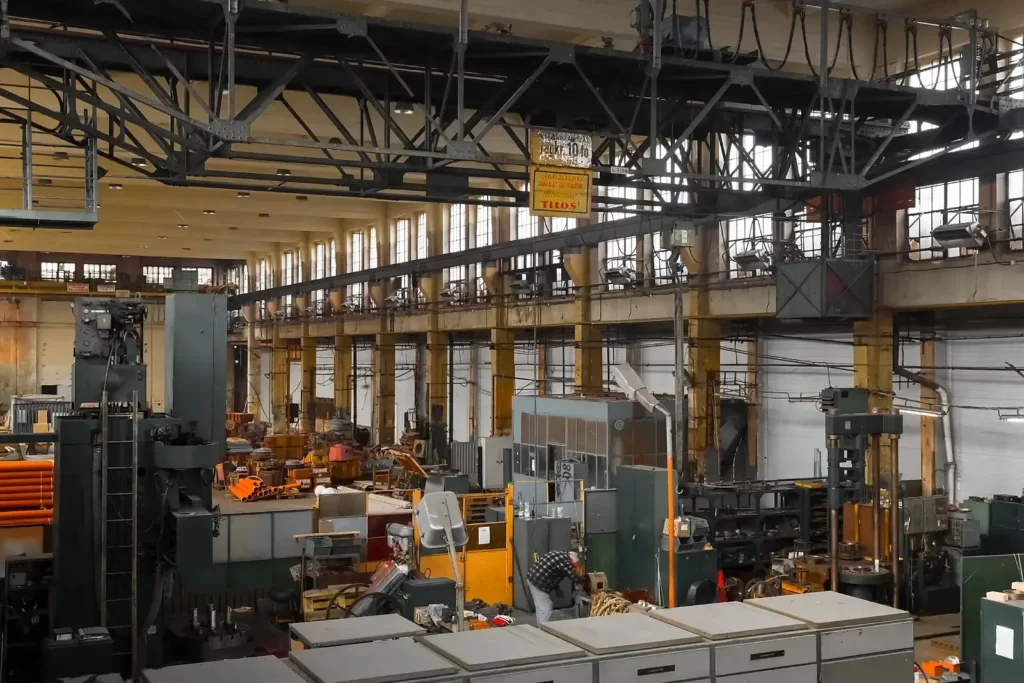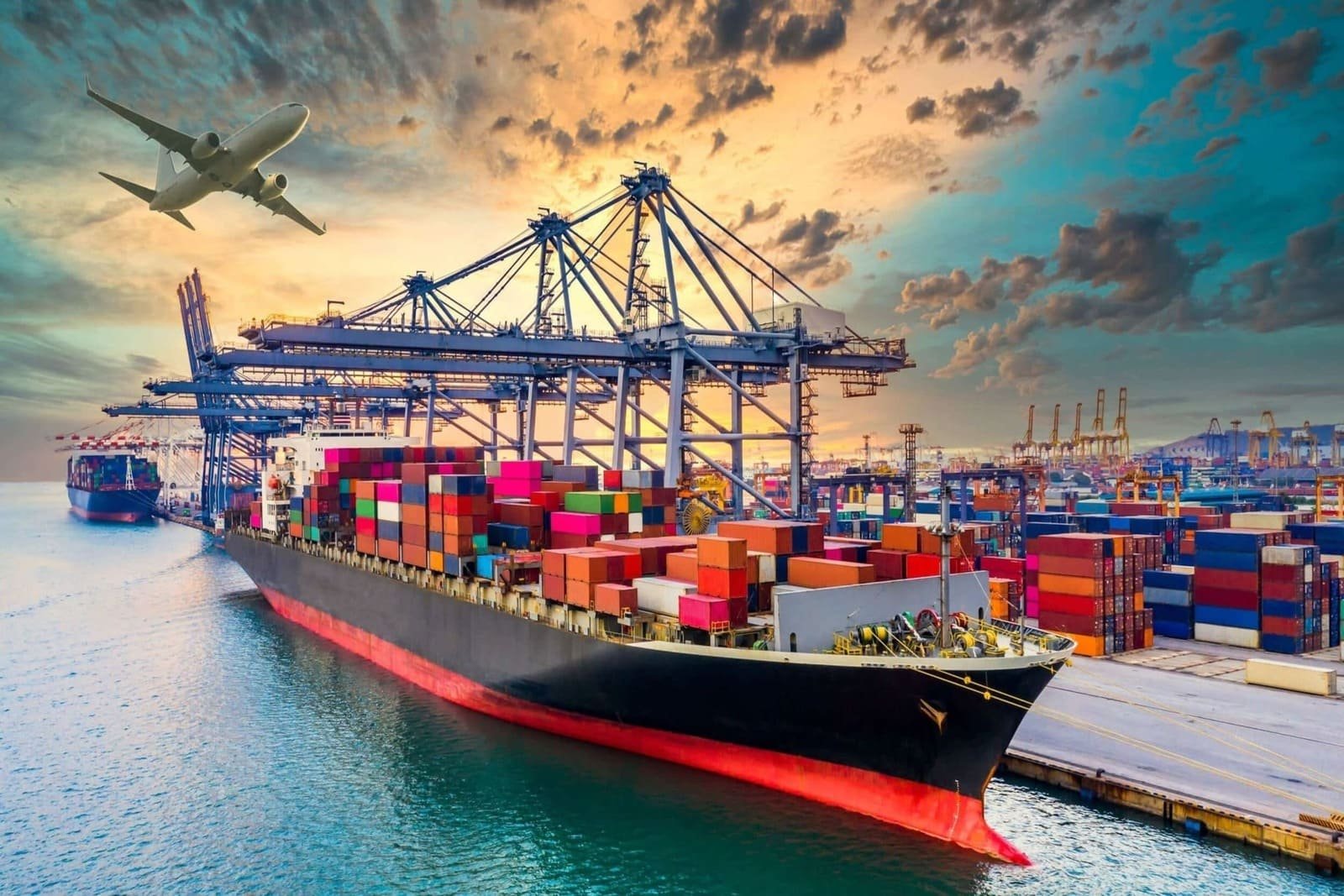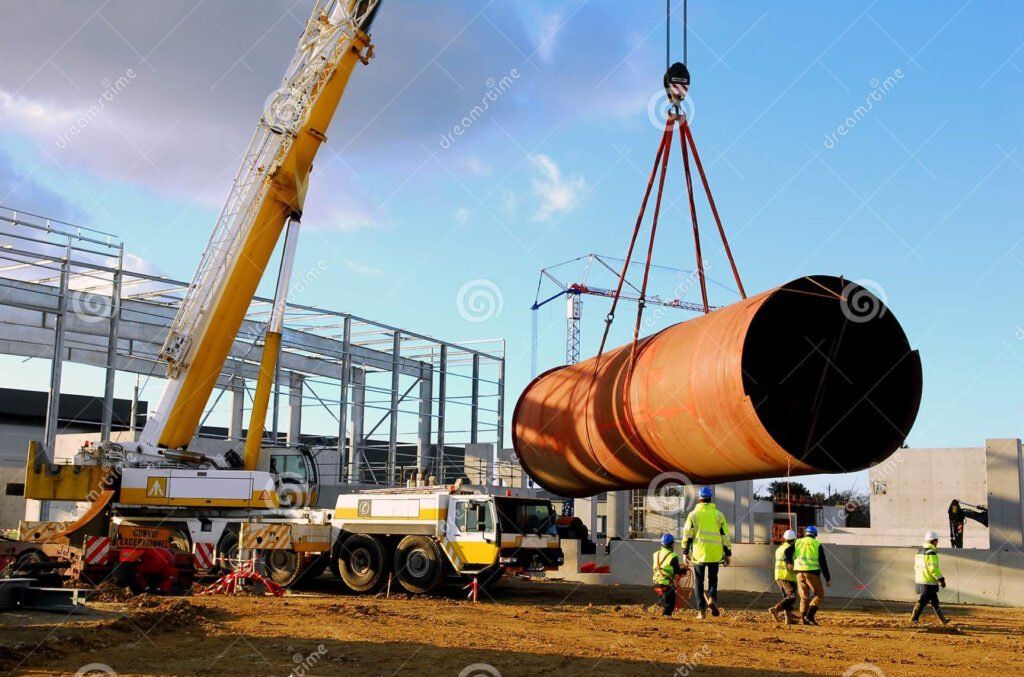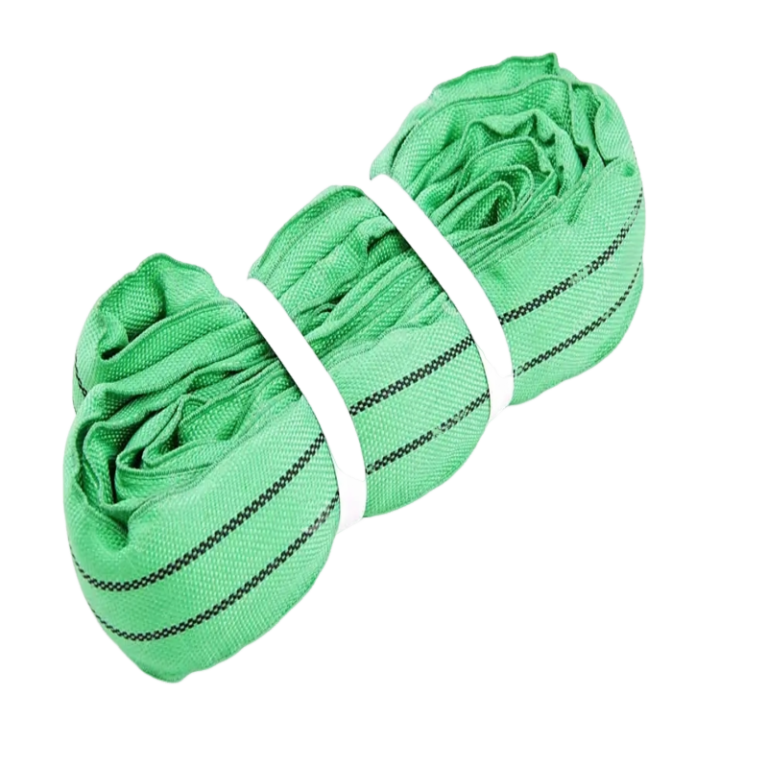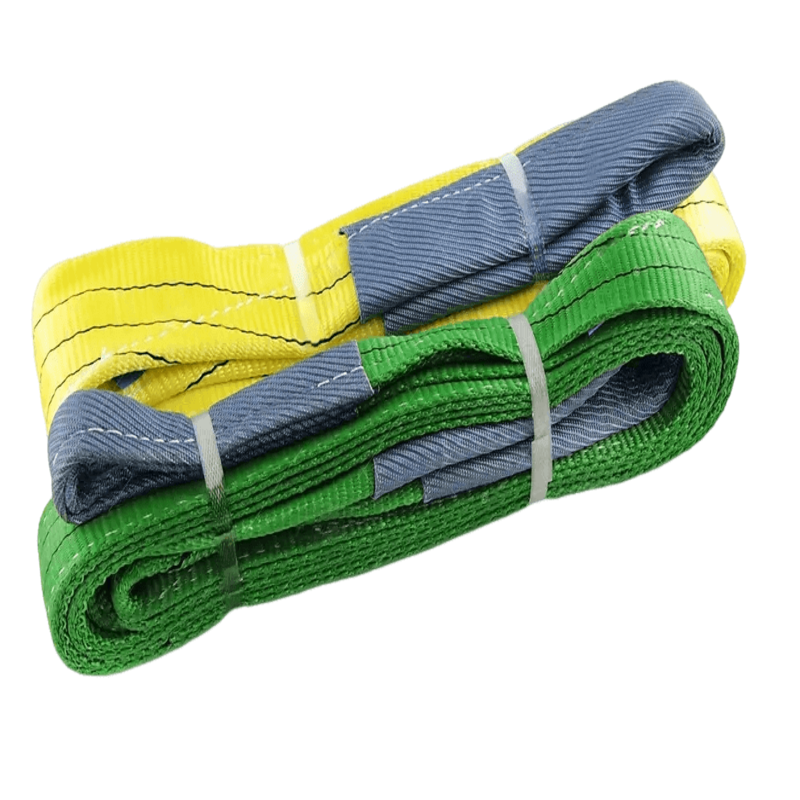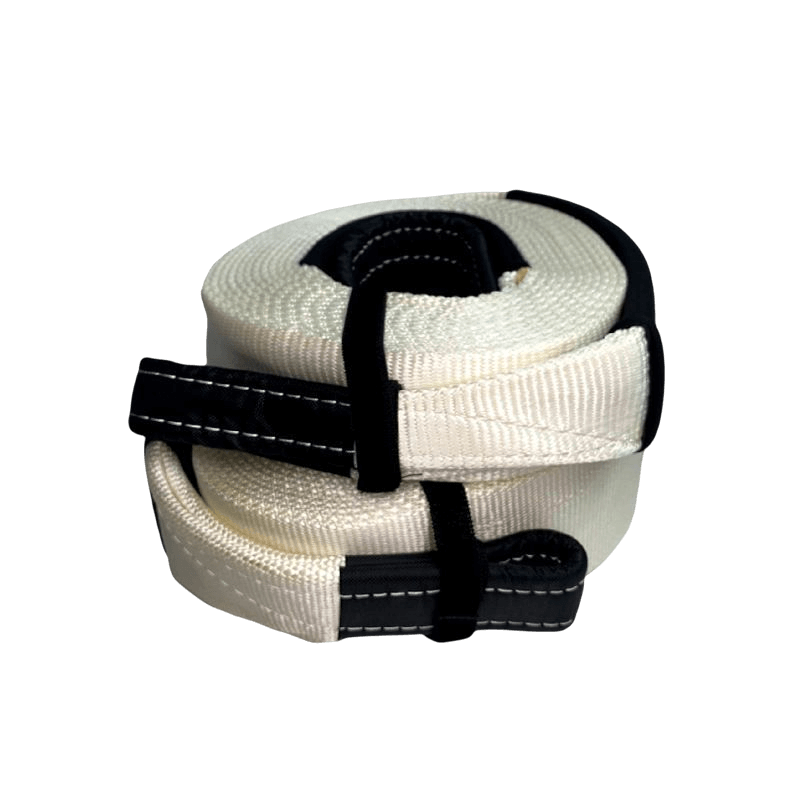CABESTERA ELEVADORA DE OJOS Y OJOS
Resistente. Confiable. Segura. Eslinga de elevación de UHMWPE para sus aplicaciones más exigentes.
¿Qué es un cabestrillo para levantamiento de ojos y óvulos?
Nuestra eslinga de elevación Eye & Eye es una eslinga de alto rendimiento fabricada con UHMWPE (polietileno de ultra alto peso molecular), generalmente recubierta con una funda o revestimiento de poliéster resistente a la abrasión. Cada extremo cuenta con un ojo reforzado que permite su conexión con ganchos, grilletes y los objetos a elevar.
Se utiliza ampliamente en manipulación de carga, minería, energía eólica, petróleo y gas en alta mar y en las industrias de construcción para levantar equipos grandes y pesados y objetos irregulares.
General Aplicaciones
Ofrecemos soluciones reales, diseñadas para las necesidades de su industria.
- control de calidad
- Tallas disponibles
Tabla de capacidad de eslingas
¡Encuentre los tamaños perfectos de eslingas de elevación para sus necesidades específicas!
| Diámetro de la cuerda mm | Diámetro de la cuerda en pulgadas | Carga de trabajo (UHMWPE) vertical | Estrangulador de carga de trabajo (UHMWPE) | Cesta de carga de trabajo (UHMWPE) | Color |
|---|---|---|---|---|---|
| mm | pulgada | Vertical | Gargantilla | Cesta | |
| 11 | 7/16 | 3260 libras (1,48 toneladas) | 2600 libras (1,18 toneladas) | 6,520 libras (2,96 toneladas) | cualquier |
| 14 | 9/16 | 4.850 libras (2,20 toneladas) | 3.880 libras (1,70 toneladas) | 9.700 (4,40 toneladas) | cualquier |
| 16 | 5/8 | 6.400 libras (2,90 toneladas) | 5120 libras (2,30 toneladas) | 12.800 libras (5,80 toneladas) | cualquier |
| 18 | 3/4 | 7.500 libras (3,40 toneladas) | 6.000 libras (2,72 toneladas) | 15.000 libras (6,8 toneladas) | cualquier |
| 22 | 7/8 | 10,390 libras (4,70 toneladas) | 83,00 libras (3,76 toneladas) | 207.800 libras (9,4 toneladas) | cualquier |
| 24 | 1 | 11.900 libras (5,40 toneladas) | 9,520 libras (4,32 toneladas) | 23.800 libras (10,80 toneladas) | cualquier |
| 28 | 1 1/8 | 18.000 libras (8,16 toneladas) | 14.400 libras (6,50 toneladas) | 36.000 libras (16,32 toneladas) | cualquier |
| 32 | 1 5/16 | 242.000 libras (11,00 toneladas) | 19.395 libras (8,80 toneladas) | 484.000 libras (22,00 toneladas) | cualquier |
| 36 | 1 1/2 | 286.500 libras (13,00 toneladas) | 22.920 libras (10,50 toneladas) | 573.000 libras (26,00 toneladas) | cualquier |
Nota: Nuestras eslingas se pueden fabricar a medida con un Límite de carga de trabajo (WLL) hasta 3000 toneladas o más
Elevación vertical: Permite suspender el objeto directamente debajo de la eslinga y elevarlo verticalmente. Fácil de usar y proporciona alta estabilidad.
Elevación de gargantilla: Implica pasar un extremo de la eslinga por el otro extremo de la carga, creando un bucle que la sujeta firmemente. Se utiliza para levantar cargas de formas irregulares, pero la capacidad de carga de la eslinga es solo de 70% a 80% menor que la de una elevación vertical debido al ángulo y los puntos de presión.
Elevador de cesta: Utiliza dos eslingas fijadas a dos puntos de la carga, formando una estructura tipo cesta. Proporciona mayor estabilidad, reduce el riesgo de vuelco y es apto para cargas de diversas formas y tamaños. Su capacidad de elevación puede ser hasta el doble que la de un elevador vertical.
- Servicio OEM
Personalización Opciones
Duracordix ofrece opciones personalizadas para satisfacer sus necesidades únicas de elevación y aparejo.
1. Longitudes y diámetros personalizados: oPodemos proporcionar eslingas HMPE/UHMWPE de tamaño preciso adaptadas a sus requisitos de carga en función de su aplicación específica, eliminando la necesidad de realizar ajustes o modificaciones inseguras.
2. Codificación de colores: Podemos personalizar los colores para una fácil identificación y aplicar recubrimientos especiales adaptados a sus necesidades para mejorar el rendimiento de la eslinga en su aplicación única.
3. Capacidades de carga personalizadas: Produciremos eslingas personalizadas en función de su peso de levantamiento, considerando el factor de seguridad, para que pueda usarlas directamente.
4. Marca: Podemos crear etiquetas personalizadas para usted, incluyendo su logotipo, información del producto, advertencias de seguridad y más.
5. Protección adicional: Para entornos hostiles, químicos o al aire libre, nuestros protectores de esquinas hechos a medida (protector de eslinga de elevación) mejoran la resistencia al desgaste y están diseñados para un uso duradero.
6. Compatible con accesorios: El tamaño de ambos ojos se puede personalizar para garantizar la compatibilidad con ganchos, grilletes u otras conexiones de equipos de elevación.
Ventajas
Principales beneficios en comparación con las eslingas de cable de acero, eslingas de cadena, correas de elevación y eslingas de cinta.
Ligero
El peso de la eslinga de elevación de UHMWPE es solo 1/8 o incluso más liviano que las eslingas de cable de acero y de cadena tradicionales, lo que la hace muy fácil de manipular y operar en tareas de elevación pesadas.
Alta resistencia
Nuestras eslingas de elevación no solo son ligeras, sino que también ofrecen mayor capacidad de elevación que las eslingas de cinta y las eslingas de cable. Su mayor resistencia reduce la necesidad de mano de obra y tiempo, garantizando así la seguridad de sus operadores.
Flexibilidad
Nuestra eslinga de elevación le ofrece una mayor flexibilidad en comparación con las eslingas de cintas de poliéster y las correas de aparejo tradicionales, lo que la hace más adaptable a diversos escenarios, especialmente en sus tareas de elevación y manipulación de objetos irregulares.
Durabilidad
Nuestras eslingas de UHMWPE, con una cubierta de poliéster de alta densidad, son resistentes a la lluvia y ciertos productos químicos. A diferencia de las eslingas de cadena y las eslingas de cable de acero, no se oxidan con el tiempo, lo que ofrece una mayor durabilidad y resistencia al desgaste en entornos hostiles.
Seguridad mejorada
Nuestras eslingas de elevación, a diferencia de las eslingas tradicionales de cable y cadena, están fabricadas con materiales más blandos, lo que reduce la fricción al entrar en contacto con equipos y otros objetos. Esto minimiza directamente el desgaste del equipo y reduce la carga durante la elevación.
Mayor eficiencia
Debido a la construcción liviana y la flexibilidad de la eslinga de elevación de UHMWPE, permite una configuración y un posicionamiento del gancho más rápidos y fáciles en comparación con las eslingas tradicionales, lo que reduce el tiempo previo a la operación, baja los costos y mejora la eficiencia general de elevación.
Mantenimiento reducido
Debido a su excelente resistencia a los rayos UV y su bajo alargamiento, la eslinga HMPE es más resistente al desgaste, duradera y libre de óxido en entornos de trabajo hostiles en comparación con las eslingas de cable de acero y las correas de eslinga de elevación, por lo que tiene una vida útil más larga y menores costos de mantenimiento.
Sostenibilidad
Las eslingas de UHMWPE son ecológicas, tienen una larga vida útil y una baja huella de carbono, lo que las hace ideales para proyectos de petróleo, gas, minería y energía eólica. Los materiales sintéticos tradicionales tienen un mayor impacto ambiental.
- Clientes felices
Cliente Voz
La eslinga de carga pesada de Duracordix ha sido un punto de inflexión en nuestros proyectos de construcción. No solo es resistente, sino también increíblemente fiable. Confiamos en Duracordix para la seguridad de nuestros equipos.
- Instrucciones fáciles y rápidas
Cómo utilizar
1. Elija el tamaño correctoElija una eslinga de elevación con el tonelaje y la longitud adecuados según los requisitos de carga de trabajo. Inspeccione cuidadosamente la etiqueta de la eslinga para confirmar que su límite de carga de trabajo (WLL) pueda soportar con seguridad el peso de la carga que se va a levantar.
2. Verificar: Las eslingas sintéticas deben inspeccionarse para detectar roturas o signos de desgaste graves. Si se detectan, deje de usar la eslinga y reemplácela. Revise ambos extremos de los ojales y los ganchos; los ojales no deben presentar roturas y los ganchos no deben estar deformados ni rotos.
3. Elija el método de elevación adecuado: Los métodos de elevación más comunes incluyen la elevación vertical, la elevación de estrangulación y la elevación de cesta. Seleccione el método de elevación más adecuado según su aplicación específica.
4. Coloque correctamente el arnés: Fije la eslinga al objeto de carga según el método de elevación requerido, asegurando una distribución uniforme de la fuerza y manteniendo el equilibrio. La eslinga no debe moverse durante la elevación. Para cargas con formas irregulares, utilice abrazaderas para asegurar la carga.
5. Conecte la eslinga al equipo de elevación: Conecte los ojales a los puntos de conexión del equipo de elevación. Asegúrese de que la carga se eleve en línea recta para evitar que la eslinga se enrede o se cruce durante la elevación.
6. Elevación y descarga: Realice una prueba de elevación para garantizar la estabilidad de la carga. Una vez estabilizada, levante la carga lentamente, manteniendo el equilibrio. Tras alcanzar la posición deseada, descargue la carga lentamente. Inspeccione los puntos de conexión de la eslinga y la superficie del cable para detectar grietas o daños, y realice las reparaciones o reemplazos necesarios.
Advertencia: Nunca exceda la carga límite de trabajo. Inspeccione la eslinga periódicamente para garantizar su correcto estado. Capacite a los operadores y siga estrictamente los procedimientos operativos. Se prohíben las operaciones no autorizadas.
Preguntas frecuentes
Respuestas a sus preguntas sobre eslingas de elevación de UHMWPE/HMPE
¿Cuáles son los principales tipos de eslingas de elevación según el material?
Dependiendo del material, la eslinga de elevación puede ser de eslinga de cinta de poliésterEslinga de cable de acero, eslinga de cadena, eslinga de UHMWPE/Dyneema (eslinga de elevación de ojo y ojo, eslinga redonda sin fin), etc.
¿Tiene una etiqueta de identificación de eslinga de elevación?
Sí, nuestras eslingas de elevación cuentan con etiquetas de inspección. Estas etiquetas muestran información como nuestro logotipo, el nombre del fabricante, la carga máxima de trabajo (CMT), la longitud, advertencias y otros detalles relevantes.
¿Puedes fabricar el protector de eslinga de elevación para ello?
Sí, podemos fabricar fundas de protección para zonas críticas de la eslinga de elevación, como los ojales o las piezas propensas al desgaste. Fabricadas en poliéster de alta densidad, estas fundas se pueden personalizar según las necesidades. Ayudan a prevenir cortes y daños en la eslinga, prolongan su vida útil y mejoran la seguridad durante las operaciones.
¿Cómo realizar el almacenamiento de la eslinga de elevación?
Limpieza y secado:Limpie la eslinga para eliminar suciedad, grasa o residuos químicos y séquela completamente para evitar la aparición de moho.
Entorno de almacenamiento:Conservar en un lugar fresco y seco, evitando la luz solar directa o condiciones de humedad para evitar dañar las fibras.
Cómo colgar y almacenar correctamente:Cuelgue la eslinga sintética verticalmente en un soporte específico y, si está enrollada, asegúrese de que esté enrollada sin apretar.
Inspección regular:Inspeccione la eslinga cada 3 a 5 meses para detectar cualquier signo de daño o deshilachado para garantizar un uso seguro para la próxima operación.
¿Cuál es el factor de seguridad de la eslinga de elevación?
Según la norma internacional ISO 10567:2005, el factor de seguridad para eslingas de elevación es de 7:1. El factor de seguridad especificado por la norma estadounidense ASME B30.9 es de 5:1. Según las normas europeas EN 1492-1 y EN 1492-2, el factor de seguridad es de 7:1. En Australia, la norma AS 4497:1997 especifica un factor de seguridad de 6:1, mientras que en China, la norma GB/T 21659-2008 estipula un factor de seguridad de 5:1.
¿Puedes hacer la eslinga de elevación con ganchos?
Sí, podemos fabricar eslingas de elevación con ambos ojos, así como eslingas de elevación con ganchos o grilletes (grillete de acero o grillete blando) para satisfacer sus necesidades de aplicación específicas.
¿Cómo acortar una eslinga de elevación?
Se trata de materiales de protección añadidos para reducir el desgaste de la eslinga, especialmente al levantar objetos con bordes afilados.
¿Cuáles son las principales aplicaciones de las eslingas de elevación?
La eslinga de elevación con ojal es versátil y se puede utilizar en diversas industrias, como la construcción, el transporte marítimo, el almacenamiento, la industria pesada, el petróleo y el gas, las operaciones offshore y la minería. Es adecuada para la elevación de grúas, la manipulación de carga, la elevación de equipos pesados, la eslinga de elevación de motores, el aparejo para aplicaciones offshore, la elevación de equipos mineros, la elevación de embarcaciones, la instalación de aerogeneradores y más.
¿También se pueden hacer eslingas con otros materiales?
Sí, también fabricamos eslingas de nailon y poliéster. Además, ofrecemos otros tipos, como eslingas de elevación planas, eslingas de cinta, eslingas de grillete y más.
¿Cuál es la máxima capacidad de carga (WLL) que puede fabricar su eslinga de elevación para trabajos pesados?
Fabricamos eslingas de elevación pesada con UHMWPE (también conocido como Dyneema o HMPE), la fibra más resistente del mundo. Nuestras eslingas alcanzan una carga límite de trabajo (CMT) de 3000 T o más.
¿Por qué es vital la resistencia química para las eslingas sintéticas?
Ciertos productos químicos pueden degradar las fibras sintéticas, comprometiendo la integridad y seguridad de la eslinga.
Eslinga de elevación o correa de aparejo: ¿cuál debería elegir?
Nuestra eslinga de elevación está hecha de UHMWPE (Dyneema), lo que ofrece un alargamiento extremadamente bajo y una fuerte resistencia a la corrosión, lo que la hace ideal para operaciones de elevación precisas de servicio pesado que requieren altos estándares de seguridad, como en la construcción y en entornos de petróleo y gas en alta mar.
Por el contrario, correas de aparejo Suelen estar hechas de poliéster, que ofrece mayor elongación, pero menor resistencia. Suelen estar equipadas con ganchos y argollas en ambos extremos y se utilizan comúnmente para asegurar o estabilizar cargas, pero su capacidad de carga no es tan alta como la de las eslingas de elevación de HMPE.
¿Sus eslingas de fibra sintética pueden ser compatibles con otros accesorios?
Nuestra eslinga de fibra sintética se puede personalizar para adaptarse a varios accesorios según sus necesidades específicas, como grilletes de acero, ganchos, fundas protectoras para los ojos, grilletes blandos, dedales o anillos.
Eslinga de cuerda redonda vs. eslinga de elevación de cuerda, ¿cuál es la diferencia?
Una eslinga de cuerda sintética Está fabricada con fibras sintéticas de alto rendimiento, como el UHMWPE, y suele emplearse una construcción de doble trenzado o de una sola trenza con funda protectora. Su estructura principal es de cuerda y suele contar con ojales en ambos extremos, lo que permite su compatibilidad con diversos accesorios de elevación. Este tipo de eslinga es especialmente adecuada para levantar y asegurar equipos grandes y objetos pesados.
Por el contrario, Una eslinga redonda de cuerda consta de un núcleo de haces de fibras de alta resistencia, como UHMWPE, recubierto por una cubierta exterior de doble trenzado. Forma un bucle continuo con forma circular cerrada, donde solo el núcleo interior soporta la carga. Extremadamente flexible, es ideal para la elevación suave de objetos cilíndricos y equipos delicados que requieren protección superficial.
¿Qué papel juegan los accesorios de eslingas en las operaciones de elevación?
Los accesorios de eslinga, como ganchos o conectores, mejoran la versatilidad y la compatibilidad. Garantizan fijaciones seguras, facilitando el control de la carga y maximizando la seguridad durante las elevaciones.
¿Cómo afectan las condiciones ambientales al rendimiento de las eslingas sintéticas?
La temperatura, la humedad y la exposición a sustancias químicas pueden degradar los materiales sintéticos. El rendimiento de una eslinga puede disminuir si no se adapta a su entorno de trabajo, lo que subraya la importancia de la elección del material.
¿Por qué los bucles de eslinga y los extremos empalmados son fundamentales durante la elevación?
Los bucles de la eslinga y los extremos empalmados están diseñados para distribuir la tensión y evitar el desgaste, ofreciendo puntos de sujeción seguros y extendiendo la vida útil de la eslinga.
¿Por qué la capacitación y la seguridad son primordiales al utilizar eslingas sintéticas?
Una capacitación adecuada garantiza que los usuarios comprendan los límites de carga, los ángulos de las eslingas y los criterios de inspección. Minimiza los riesgos, promueve las mejores prácticas y garantiza que las operaciones de elevación se mantengan libres de accidentes.
¿Cómo afecta el “equilibrio de carga” la eficiencia y la seguridad de las operaciones de elevación utilizando eslingas sintéticas?
El balanceo de carga garantiza una distribución uniforme del peso en toda la eslinga. Evita tensiones excesivas en una sección, lo que reduce el riesgo de rotura y garantiza una elevación más segura y estable.
- Hacemos más
Relacionado productos
Explore nuestra gama de productos relacionados con eslingas de elevación para un mejor rendimiento

